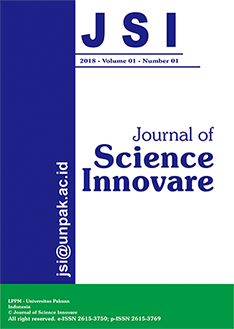Journal of Science Innovare
Vol 8, No 1 (2025): Journal of Science Innovare, Volume 08 Number 02 2025
Articles

Journal of Science Innovare is a journal that publishes scientific papers. This Journal, run by Lembaga Penelitian dan Pengabdian Pada Masyarakat, Universitas Pakuan, Bogor. The Journal provides opportunities for scholars to submit papers in a primary article sourced directly from the results of Basic Science and the Environment. fields which will be published online. The internet connection will add to the richness of information and scientific knowledge derived mainly from research. This journal is published two times a year, well documented in the form of books, which include a variety of Science Innovare papers by writers of various backgrounds. In addition, we also have partners from local editor who graduated as profesor from some university who will review each article before publication. Each article or paper published in this Journal will definitely be useful to all visitors and readers.
Journal of Science Innovare is an academic journal that publishes scientific papers in the field of Science Innovare. This journal is published two times a year (March and September) by Lembaga Penelitian dan Pengabdian Pada Masyarakat, Universitas Pakuan Bogor since 2017. The scope of journal are: all science and technology research areas including Physics, Chemistry, Biology, Mathematics, Statistics, Biodiversity, Food Science Technology, Engineering Science and Educational Science.
Articles submitted to this journal will be reviewed by reviewers before publication by double blind-review. e-ISSN: 2615-3750 dan p-ISSN : 2615-376
All articles published in Journal of Science Innovare has been indexed in:
 |  |  |  | |
 |  |  |  |


















